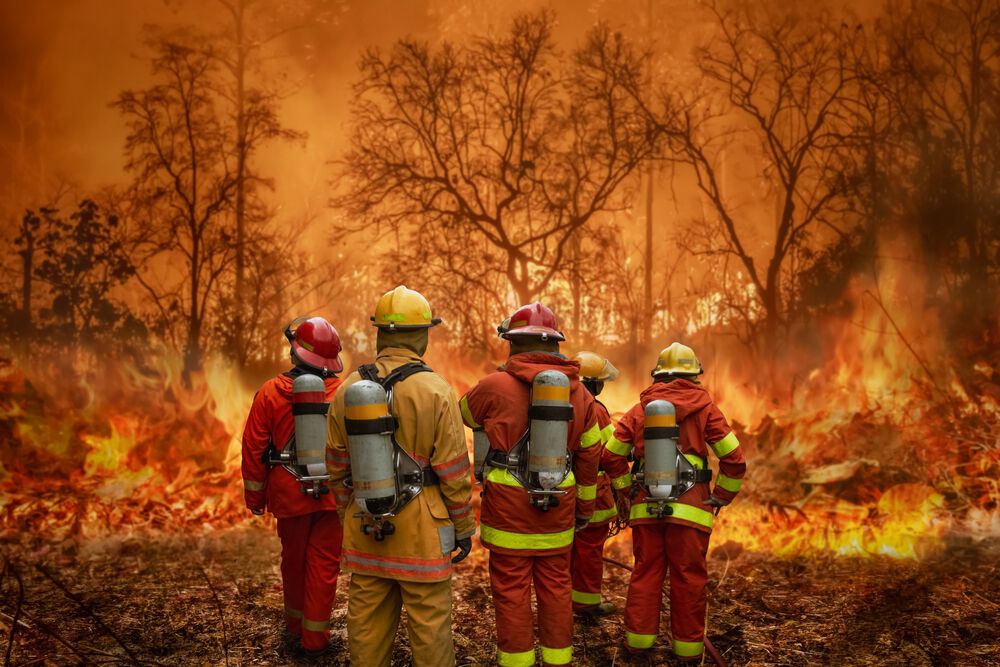Wildfires have become increasingly prevalent in recent years, leaving a trail of destruction in their wake. Beyond the immediate threat of flames, the smoke generated by these wildfires poses a significant health risk to those exposed to it. In this article, we'll delve into the health effects of wildfire smoke exposure and provide essential tips on how to protect yourself and your loved ones during a wildfire smoke event.
Understanding Wildfire Smoke
Before we explore the health impacts, it's crucial to understand what wildfire smoke consists of and how it can affect air quality. Wildfire smoke is a complex mixture of gases and fine particles, including carbon dioxide, water vapor, carbon monoxide, and tiny particulate matter. These smoke particles can vary in size, with the smallest, upon smoke inhalation, being the most harmful to health.
Wildfire smoke can travel vast distances, affecting communities far from the fire's epicenter. A wildfire smoke event spreads through the atmosphere, often blanketing large regions and resulting in poor air quality.
Health Effects
Short-Term Health Effects
Wildfire smoke exposure, even for a short duration, can have immediate health consequences. According to the Centers for Disease Control and Prevention (CDC), even healthy individuals are at risk of the following if the smoke inhalation is bad enough:
- Coughing
- Trouble breathing
- Stinging eyes
- Scratchy throat
- Runny nose and sinus irritation
- Wheezing
- Shortness of breath
- Chest pain
- Tiredness
- Fast heartbeat
- Asthma attack
- Headaches
Long-Term Health Effects of Wildfires / Wildfire Smoke on Health and Sleep
Repeated exposure to wildfire smoke particles over time can have more severe and long-lasting consequences and significantly affect our sleep. These may include:
1. Chronic Respiratory Conditions: Prolonged exposure can increase the risk of developing lung disease and chronic respiratory conditions, such as bronchitis, or the worsening of existing conditions.
According to UCLA Health, people enduring chronic lung disease and lung conditions that make breathing difficult, such as asthma, bronchitis, emphysema and COPD, are particularly vulnerable to the adverse effects of the poor air quality caused by wildfire smoke. Air contaminated by wildfire smoke also poses some health risks to infants, children, older adults and pregnant women.
2. Cardiovascular Issues: There is evidence to suggest that exposure to wildfire smoke can also have adverse effects on cardiovascular health, potentially leading to heart attacks and other cardiac issues.
When household waste, like wood and leaves, are burned, they produce smoke, which contains vapors and particulate matter (PM). Prolonged exposure to PM is associated with cardiovascular disease, respiratory diseases, lung cancer, and COPD, while short-term exposure can have a negative impact on our sleep.
3. Mental Health Impacts: The stress and anxiety associated with living in wildfire-prone areas and the uncertainty during fire events can take a toll on mental well-being.
According to a study made on survivors of a wildfire in Llia, Greece, the presence of insomnia was identified in 63% of the survivors, and the majority of them were older females, who had also developed PTSD. Over half of the participants in the study also shared experiencing what was best described as “fear of imminent death.”
4. Poor sleeping patterns: Inadequate sleep, caused by the poor air quality resulting from wildfire smoke, makes many less capable of coping with the acute dangers of wildfires and managing everyday life.
In a systematic review of multiple sleep studies that range over a 9-year period from 2012-2021, sleep disturbances were seen to be highly prevalent with wildfire survivors, and the proximity and severity of traumatic exposure of the survivor creates an even more vital link.
Vulnerable Populations
Certain groups are particularly vulnerable to the health effects of wildfire smoke. These include:
1. Children: Children's developing respiratory systems make them more susceptible to harm from smoke exposure.
2. Elderly: Older adults may have pre-existing health conditions that make them more at risk for severe health impacts.
3. Individuals with Pre-existing Conditions: Those with asthma, COPD, heart disease, or diabetes are at higher risk of exacerbated symptoms during smoke exposure.
To protect these vulnerable populations:
- Ensure that children and the elderly have access to clean indoor air.
- Stay informed about air quality levels in your area to take appropriate precautions.
- Encourage individuals with pre-existing conditions to have an action plan in case of smoke exposure.
How to Protect Your Health
Staying Indoors
When air pollution and smoke levels are high, it's best to stay indoors. Create a safe indoor environment by:
- Keeping windows and doors closed.
- Using air purifiers with HEPA filters to trap fine particles.
- Avoid activities that generate indoor air pollution, such as smoking or using candles.
- The CDC also suggests to not do any vacuuming since it can stir up dust and other particles in the home.
Monitoring Air Quality
Keeping an eye on air quality is crucial during wildfire events. Websites and apps provide real-time air quality data for your area. Pay attention to air quality indexes and follow any local advisories.
When possible, acquire a freestanding digital air filter. This will prove helpful in both raising the quality of the air indoors, and also be your own personal monitor of the air quality in your home.
Wearing Masks
Wearing N95 or P100 masks can be effective in reducing smoke exposure. These masks filter out fine particles, providing some protection when you need to go outside. Make sure the mask fits snugly and is certified for particulate filtration.
Generally, most surgical or cloth face masks aren’t recommended as they don’t provide much added protection from wildfire smoke since the particles are too small to be effectively blocked by such coverings.
Evacuation Planning
In extreme situations, evacuation may be necessary for your safety. Prepare an evacuation plan that includes:
- Essential supplies like food, water, medications, and important documents.
- A communication plan with family and friends.
- A designated meeting point if you get separated
Coping with Associated Anxiety
Dealing with the uncertainty and stress of wildfire events can be challenging. To manage anxiety:
- Stay informed but limit exposure to distressing news.
- Practice relaxation techniques like deep breathing or meditation.
- Reach out to friends and family for support.
- Lean on community resources. During wildfires, communities often come together to provide support. Seek out local resources and organizations that can assist with emergency services, shelter, and relief efforts. Feel free to ask for help when needed.
Use Mattress and Pillow Protectors
Waterproof pillow protectors and hypoallergenic mattress covers are an effective way to better ensure vapors and particulate matter from wildfire smoke don’t end up being permanently embedded into your mattress and pillows.
At Mancini’s Sleepworld, our protectors help you maintain a healthier sleep environment by creating a barrier that safeguards your mattresses and pillows from moisture, bacteria, and allergens. Machine washable, our protectors are also easy to maintain. Simply remove from the mattresses and pillows, put in the wash, and return to your beddings once dried for continuous protection from vapors, particulate matter, allergens, and the like.
Indeed, the health effects of wildfire smoke are a growing concern, but by understanding the risks and taking proactive measures, you can protect yourself and your loved ones. Prioritize monitoring air quality, creating a safe indoor environment, and having an evacuation plan in place. Stay safe, stay informed, and be prepared to weather the challenges that wildfires may bring.
References:
1. “Wildfire smoke dangerous to those with lung conditions” | Uclahealth.org Publisher: UCLA Health Year: 2022 URL: https://www.uclahealth.org/news/wildfire-smoke-dangerous-to-those-with-lung-conditions.
2. “Fine particulate matter: The culprit for chronic lung diseases in China By Tao Li, Rong Hu, Zi Chen, Qiyuan Li, Shouxiong Huang, Zhou Zhu, Linfu Zhou” | Chronic Diseases and Translational Medicine Publisher: KeAi Year: 2018 Volume: 4 Issue: 3 DOI: 10.1016/j.cdtm.2018.07.002 URL: https://www.ncbi.nlm.nih.gov/pmc/articles/PMC6160608/
3. APA PsycNet | Apa.org Year: 2023 URL: https://psycnet.apa.org/record/2017-22120-010
4. “Air pollution exposure and adverse sleep health across the life course: A systematic review
By Jianghong Liu, Tina Wu, Qisijing Liu, Shaowei Wu, Jiu-Chiuan Chen” | Environmental Pollution Publisher: Elsevier BV Year: 2020 Volume: 262 DOI: 10.1016/j.envpol.2020.114263 URL: https://www.ncbi.nlm.nih.gov/pmc/articles/PMC7877449/
5. “A Systematic Review of the Impact of Wildfires on Sleep Disturbances By Fadia Isaac, Samia Rachael Toukhsati, Mirella Di Benedetto, Gerard Kennedy” | International Journal of Environmental Research and Public Health, Publisher: Multidisciplinary Digital Publishing Institute Year: 2021 Volume: 18 Issue: 19 DOI: 10.3390/ijerph181910152 URL: https://www.ncbi.nlm.nih.gov/pmc/articles/PMC8508521/

